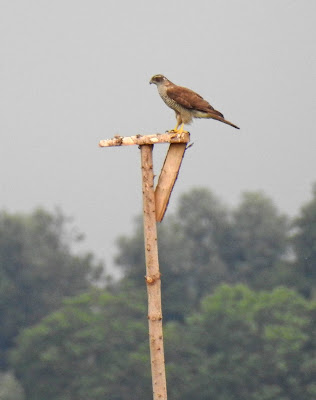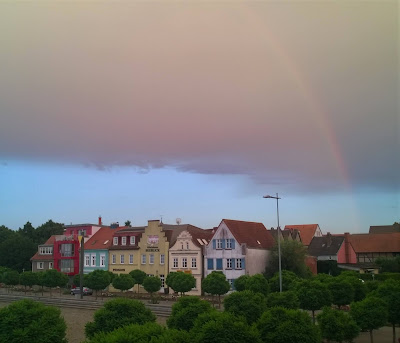The plan was to make a tour of about 260 km through the German states of Brandenburg and Mecklenburg-Vorpommern, in three stages: the Oder valley (100 km), island of Rugen (130 km), and Mecklenburg Lake plateau (30 km) - calling in at Rostock on the way, and finishing with a beer in Berlin, and putting my bike on trains for connections.
The first stage of about 100 km began when I took my bike off the train at Angermunde, about 80 km north-east of Berlin and close to the border with Poland formed by the River Oder. I would first cycle to the closest part of the river at Stolpe, go downstream until it entered Poland after about 50 km, then cut cross country to Locknitz, between Szczecin and Pasewalk, to catch a train to Rugen.
The Lower Oder Valley is a nature reserve, covered by cycle tracks.
It is Auenwald - riparian forest in English.
On the road out of Angermunde I passed a memorial to Soviet soldiers killed during WWII.
They would have died in the first phase of the Battle of Berlin - which began when the Oder was crossed on April 16th 1945, and finally ended when the war ended - three weeks and one-quarter of a million deaths later.
The Oder Valley is now a peaceful place, full of bird song.I listened to the stuttering trills of Corn Buntings (Emberiza calandra) ...
...and I followed the calls of the cuckoos (Cuculus canorus) to watch them singing on their perches.
By the river I caught my first view of a Crane (Grus grus). This was one of the birds I especially wanted to see, as this part of Germany is the furthest west they breed - most spending summers up into Scandinavia and Russia.
Soon I had seen my second target bird, the White-tailed Eagle (Haliaeetus albicilla). They are resident here but, like the cranes, many will spread up into the far north-east of Europe for summer.
When I reached the border with Poland, I was tempted to carry on along the river and visit the Polish city of Szczecin, only 20 km away - but after thoughts of bad roads full of trucks further along the way, I decided to stick to plan A.
By the border was another war memorial, this time to German soldiers who had been killed during the Soviet and Polish advance. It reads: think of all the war dead - love truth and peace.
The current border between Germany and Poland is testament to the cost of warfare. During the Weimar Republic, before 1914, the area of Germany was amost half a million square kilometres - Prussia stretching east as far as Lithuania. After WWI & WWII this area had been reduced by around a quarter.
Leaving Szczecin behind me, I pedaled cross-country through fields of wild flowers to Locknitz...
...and boarded a train at the Bulgarian-German restaurant otherwise known as Locknitz station.
I arrived in the Hanseatic City of Stralsund. It was part of Sweden from 1628, after the Thirty Years war, then Prussia again took control in 1815 after the Napoleonic wars. It is the constituency of Angela Merkel, who has been in power there since 1990. From here I would begin my 130 km tour around Rugen, Germany's largest island.
A motorway suspension bridge connecting Stralsund to Rugen island was opened in 2007, but with the bicycle I crossed the old Rugen Causeway, which includes the Ziegelgraben 'bascule' (drawbridge). It opens regularly to let shipping pass.
Rugen is mostly farmland surrounded by beaches, and I had a peacful tour accompanied by Meadow Pipits (Anthus pratensis)...
...and Yellowhammers (Embiriza citrinella).A Goshawk (Accipiter gentilis) perched over a meadow.
Again, another glimpse of cranes.
At the north-east of the island is the Jasmund National park, a beech forest which culminates in white chalk cliffs up to 160 m in height. Many of the roads in this part of Germany are still cobbled, which is not the best substrate for a bike. When I left the high point of Jasmund I was happy to see that the long winding road back down to sea level was pathed with state of the art EU-funded tarmac, allowing me to freewheel down at an exhilarating speed. I then remembered that I was not on a racing bike, but on a touring bike with heavy panniers, and it was not prudent to travel at great speeds. This thought occurred to me as I was flying through the air after hitting a curb.
I managed to make my way to Sassnitz with just blooded knees and a bent front fork.
The fork was straightened at the local bike shop, and I checked into a room with a sea view for a few days to lick my wounds and mend my pride.
Bruised, bandaged, but full of beans, I made my way back to Stralsund, and caught the train to another Hanseatic city - Rostock.
Rostock University was founded in 1419, and its zoology department has a collection that dates back to 1775. It's a good place to get an idea of how a big a white-tailed eagle really is.
Perhaps the most famous specimen in the collection is the Rostocker Pfeilstorch. Pfeilstorchs are storks that are injured by arrows whilst wintering in Africa, and return to Europe with the arrows stuck in their bodies. Twenty-five such cases have been documented. The one here is the most famous. It was found in 1822 in the village of Klutz, 80 km along the coast west of Rostock, with a central African spear in its neck. Its discovery proved that birds may migrate very long distances south to warmer areas for the winter, and the disapearance of storks from Europe each year was no longer a mystery.
Midway between Rostock and Berlin is the Mecklenburg Lake plateau. I took the train to Waren, and cycled the 30 km to Neustrelitz - through the Muritz national Park.
After leaving Waren, I was having regular sightings of another bird I was hoping to see - the wonderful fish-eating Osprey (Pandion haliaetus), which dives into lakes to catch its prey. It is a global species, and in Europe breeds in the far north-east of Europe as the crane and white-tailed eagle (though a few resident populations can be found in the western Mediterranean).
At the park information centre in Federow I saw there was a big programme to protect the osprey. Nests with cameras have been erected on the pylons nearby, so that visitors can watch the rearings.
And for those who wonder what it would be like to see an osprey hunting up close, there is a stuffed specimen hanging from the ceiling doing exactly that.
Further on I glimpsed yet more cranes in the distance.
But the best was yet to come. I turned the corner of quiet country road and there, not many metres into a field, stood a crane. I dropped my bike and peaked from behind a tree, expecting the crane to have already flown. But it hadn't, and I had the closest views I have ever had and likely ever will have.
At Neustrelitz my cycling tour was over. I put my bike on the train to Berlin, to have that celebratory beer in the Mitte before returning to Basel.
The last time I had been in the Mitte was nearly forty years earlier, in 1978. Then, I arrived at Freidrichstrasse railway station, in what was East Berlin, on a train from Warsaw in Poland where I had been visiting a friend's aunt. The streets were quite deserted. Naively I asked the attendant at the art museum if there'd been a fire in the cathedral, and he told me that British and American bombers were responsible for that. The art gallery did not contain the Durers I had hoped to see, just some propaganda 'art'. I don't know where I crossed the wall into West Berlin, but it was a small affair without a road crossing. It had been raining, and the officer in charge laid his coat on a wet bench for me, a scruffy 18 year old, to wait whilst he inspected his troops. Then he examined my papers and, with continued Prussian charm, wished me well.
I was now in a united Berlin, and I felt from a different time.The cathedral (Dom) had been restored, teenagers were drinking coffee on the terrace of the Dom Cafe, the streets were full of tourists, and the Reichstag building had an impressive glass dome.
Berlin has a great natural history museum in which, like most great natural history museums, you are greeted in a hall full of dinosaurs - including the largest mounted dinosaur skeleton in the world, of a Giraffatitan brancai.
There is an exhibition on evolution.
Of course, pride of place is given to their own Alexander von Humboldt - the great naturalist and explorer of the beginning of the 19th century, who inspired the young Charles Darwin to make his famous trip around the world on the Beagle.
Also immortalised in plaster, Ernst Mayer - one of the leading evolutionary biologists of the 20th century. Mayer's first job was at the natural history museum. In 1931 he emigrated to the U.S., to take up a position at the American Museum of Natural History in New York, and in 1942 published the definition of the species that still holds today. He spent most of the rest of his life as the director of the Museum of Comparative Zoology at Harvard University, and died in 2005 at the ripe old age of 100. I was introduced to him once at a meeting in London, and shook his hand.Here again, taxidermy is used to great effect at capturing animals in their natural poses.
A statue of Humboldt is also, appropriately, outside of Berlin's Humboldt University. Founded in 1810, it has since been home to 57 Nobel Prize laureates. Ernst Mayer did his PhD here, in ornithology.
A statue of Humboldt is also, appropriately, outside of Berlin's Humboldt University. Founded in 1810, it has since been home to 57 Nobel Prize laureates. Ernst Mayer did his PhD here, in ornithology.
The statue of Max Planck is of a more humble design.
In the entrance to the University you are greeted with the following quote from Karl Marx (who studied here) in huge golden letters on marble: "Philosophers have hitherto only interpreted the world in various ways; the point is to change it".
That evening I went to the Brandenburg Gate. What was once a symbol of division was now a huge television screen. I stood amongst thousands of united Germans watching their country play France in the Euro 2016 semi-final.
France knocked Germany out of the competition 2-0 - both goals scored by this man, Antoine Griezmann, the son of a German.
Yesterday evening I watched Germany play again, this time in Euro 2020, in a 'sports' bar in the Dordogne. I was alone. France had been knocked out the day before, which must have resulted in a drop in interest, and this is a region of rugby.Germany were again knocked out 2-0, only this time by England. And you thought the Berlin wall would never fall.






























































No comments:
Post a Comment